| FEBRUARY 2017 |
|
3 shows in T˘ky˘ (Kabukiza, EX THEATER), 2 in Fukuoka (Hakataza), 2 in ďsaka (Sh˘chikuza) and 1 tour (Zenshinza)!
|
| Kabukiza (T˘ky˘) |  |
| Dates | 2 ~ 26 February 2017 (Saruwakasai Nigatsu ďkabuki) Saruwaka Festival February Grand Kabuki |
| MatinÚe |
Saruwaka Edo no Hatsuyagura ďakinai Hiru-ga-Kojima ďgi Jishi |
| Evening | |
| Casting |
Living National Treasure Onoe Kikugor˘, Living National Treasure Nakamura T˘z˘, Nakamura Tokiz˘, Nakamura Jakuemon, Nakamura Shikan, Nakamura Baigyoku, Nakamura Kaishun, Nakamura Ganjir˘, Nakamura Kankur˘, Nakamura Shichinosuke, Onoe Kikunosuke, Kataoka Takatar˘, Nakamura Kinnosuke, Ichikawa Somegor˘, Onoe Sh˘roku, Kataoka Hidetar˘, Band˘ Hikosabur˘, Ichikawa Sadanji, Band˘ Yajűr˘, Nakamura Karoku, Nakamura Kantar˘, Nakamura Ch˘zabur˘ |
| Comments |
Nakamura Kankur˘'s two sons Nakamura Kantar˘ III and Nakamura Ch˘zabur˘ II make their debut on stage (hatsubutai)! These two programs also celebrate the 390th anniversary of Edo Kabuki. Saruwaka Kanzabur˘ received a license from the authorities to open a theater in Edo the 15th day of the 2nd lunar month of the 10th year of the Genna era, which was the 2nd of April 1624 in the western calendar. In 1627, the Saruwaka no Mai, the Saruwaka Dance, was staged for the first time in Edo.
|
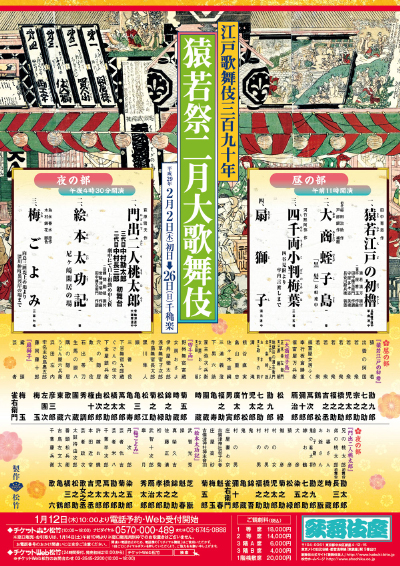 |
| Sh˘chikuza (ďsaka) |  |
| Dates | 1 ~ 25 February 2017 (Nigatsu Hanagata Kabuki) February Young Actors Kabuki |
| MatinÚe |
|
| Evening | |
| Casting |
Nakamura Matagor˘, Onoe Matsuya, Nakamura Baishi, Nakamura Kazutar˘, Nakamura Kash˘, Band˘ Shingo, Nakamura Tanenosuke, Onoe Ukon |
| Comments |
A special Kabuki program with seven young actors.
|
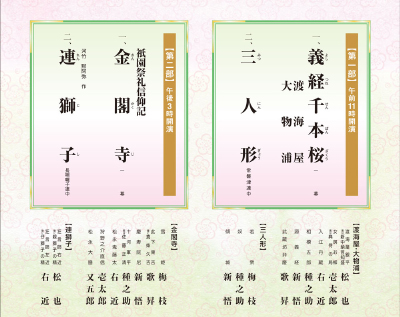 |
|
|||
| Dates | 3 ~ 26 February 2017 (Nigatsu Hanagata Kabuki) February Young Actors Kabuki |
||
| MatinÚe |
Otoko no Hanamichi Hade Sugata Omodaka Matsuri |
||
| Evening |
Yukinoj˘ Henge |
||
| Casting |
Ichikawa Ennosuke, Ichikawa Monnosuke, Band˘ Takesabur˘, Ichikawa Emisabur˘, Ichikawa Emiya, Ichikawa En'ya, Ichikawa Juen, Ichikawa Omez˘, Band˘ Minosuke, Nakamura Yonekichi, Nakamura Hayato, Ichikawa K˘tar˘, Nakamura Umemaru |
||
| Comments |
A special Kabuki program with the Omodakaya guild led by Ichikawa Ennosuke:
|
||
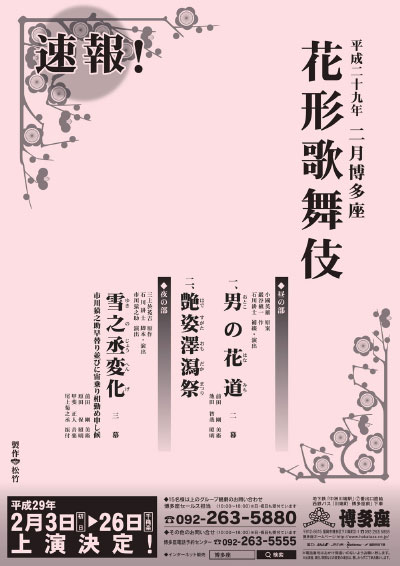 |
| EX THEATER (T˘ky˘) |  |
| Dates | 4 ~ 20 February 2017 (Roppongi Kabuki) Roppongi Kabuki |
| Program |
Zat˘ Ichi |
| Casting |
Ichikawa Ebiz˘, Terajima Shinobu, Ichikawa Udanji, Kataoka Ichiz˘, Ichikawa Udanji, Ichikawa Kudanji, Ichikawa Shinz˘, Band˘ Shinsha, ďtani Hiromatsu, Ichikawa Fukutar˘, Ichikawa Fukunosuke, Ichikawa Fukumaru |
| Comments |
Second edition of the Roppongi Kabuki performances at the EX THEATER. Based on a script written by Lily Franky, the stage direction is done by the famous movie director Miike Takashi, an expert in violent and bizarre movies who worked twice with Ichikawa Ebiz˘ for the movies "Hara-Kiri: Death of a Samurai" (2011) and "Over your Dead Body" (2014). The story is about Zat˘ Ichi, the zat˘ Ichi, a blind masseur and blademaster who was created by novelist Shimozawa Kan. The guest star of this production is not a Kabuki actor but the actress Terajima Shinobu, the daughter of Living National Treasure Onoe Kikugor˘. |
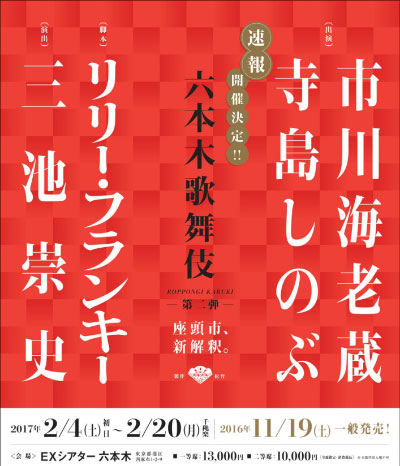 |
| Zenshinza Tour | |
| Dates | ??? ~ ??? February 2017 |
| Program |
Ushiwakamaru |
| Casting |
Hayase Einoj˘, Motomura Yűki, Watarai Motoyuki |
| Comments |
A February and March tour all over Japan for the Zenshinza troupe with the staging of the newly-created Kabuki drama "Ushiwakamaru"! Among many others dates, they perform the 27th of February 2017 in T˘ky˘ at the Asakusa K˘kaid˘.
|
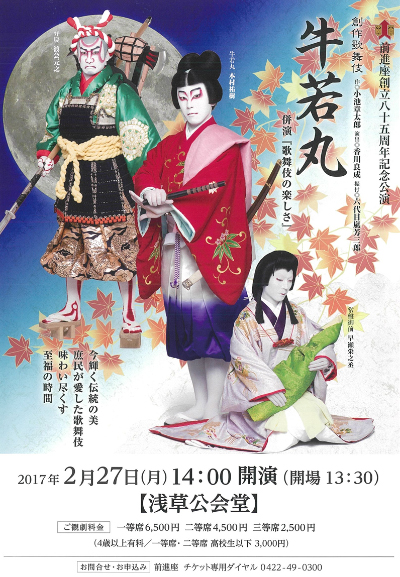 |
|
|
| Contact | Main | Top | Updates | Actors | Plays | Playwrights | Programs | Links | FAQ | Glossary | Chronology | Illustrations | Prints | Characters | Derivatives | Theaters | Coming soon | News |
